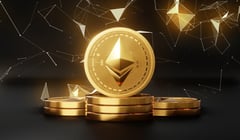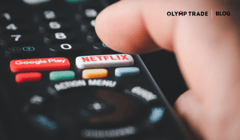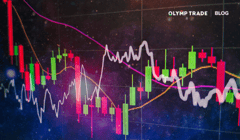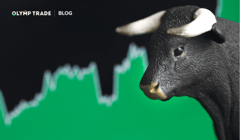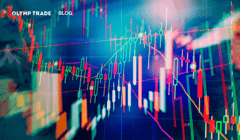
Inflation in the U.S. is breaking all records. In order to curb the rise in prices, the interest rate needs to be raised, but how can this be done when energy prices are rising globally? All the problems of the European and U.S. economies are in our weekly digest today.
Interact with the dashed blue word and green spot on images to get additional details and explanations.
More details on the visuals will be here.
A term definition or explanation will be here.
Contents
Weekly Trends
Chevron ↑ 9.36%
Trading up with $100 and a X20 multiplier on Forex Olymp Trade, you could have easily made $187.2.
EUR/CHF ↑ 2.06%
Trading up with $100 and a X500 multiplier on Forex Olymp Trade, you could have easily made $1030.
Microsoft ↓ 3.49%
Trading down with $100 and a X20 multiplier on Forex Olymp Trade, you could have easily made $69.8.
Currency Markets
Rising Inflation in the U.S.
During the week, the situation on the currency markets did not change much. The U.S. dollar is growing slightly against other currencies. The strongest movements are seen in EUR/USD, which is consolidating around 1.10000 and in USD/CHF, which is trying to test the strength of 0.93000.

U.S. inflation data was released on Thursday 10.03. CPI came in at 7.9%. This is the highest since 1982. This means that the Fed needs to raise the interest rate.

On the other hand, a sharp increase in the rate will lead to an increase in the cost of debt service, which in the U.S. is already overwhelming. Therefore, the U.S. needs to take urgent measures to reduce energy prices. This is especially pressing after the U.S. ban on oil imports from Russia.
ECB Rate – 0%
The European Central Bank is also in no hurry to tighten monetary policy. At the last meeting, the ECB decided to keep its key rate at 0%. Christine Lagarde reported that inflation will be higher for longer than expected. In fact, the head of the ECB is warning investors not to count on a quick recovery of the situation. Moreover, the ECB is planning to stop buying assets under PEPP at the end of March, while the APP will continue until the end of Q2 2022.
In this regard, we again recommend paying attention to the EUR/USD currency pair. We expect that EUR will continue to decline against the U.S. dollar. A strong support level for EUR/USD is at 1.08000, and resistance is at 1.12000.

Resistance level of 1.1200.
Support level of 1.0800.
Stock Markets
U.S. Market is Heading Lower Again
The U.S. stock market started declining again, albeit at a rather weak pace. The Dow Jones is attempting to test the strength of the level at 33,000 points. Bulls are still holding on; however, we think that their strength won't last long. Over the week, the index was down almost 3%. The Nasdaq100 index broke below 14,000 points, and there was a small pullback towards the end of the week. At the same time, the decline for the week was about 5.3%. The S&P 500 is trying to rebound from 4,200 points. At the time being, upward movement of key U.S. indices should be viewed as a correction and should not be regarded as a change of trend. Keep in mind that the Fed meeting is only one week away. With the current uncertainty in the markets, the committee is unlikely to increase the rate drastically, but it will raise the rate by 25 basis points.

It is also worth noting that the Fed has already ended QE, which will no longer support the U.S. stock market.

Amazon Attempting to Gain Ground with Stock Split
Amazon's share price tested $2,700. Overall, the stock's movement is in line with the general trend in the stock market. The Beta of the stock is 1.14, which means that the price of the stock will actually outpace the movement of market indices. Meanwhile, closer to the middle of the week, the stock was trying to grow on the news of a buyback and a possible stock split of 20:1. Currently, the support level for Amazon is at $2,700 and the resistance level remains at $3,000.

Resistance level of $3,000
Support level of $2,700
Commodity Markets
Oil and Gold are Close to Historic Highs!
Brent oil set another price record at $131.1 per barrel. Historically, prices have been higher only once, in July 2008. At that time, oil was $147.5 but remained at that level for a very short period of time.
As expected, after being severely overbought, there was a sharp drop in price. Daily RSI came out of the overbought area and returned to its normal value. The price stabilized at $111, which corresponds to the 2.236 Fibo level of the current uptrend.

RSI returns back to the normal range
Uptrend line
Local maximum
Less than $17 separated the asset from the historic high. Although if you add inflation to the equation, it turns out that the growth margin is quite large because the purchasing power of USD was much higher 14 years ago. JP Morgan and Goldman Sachs believe the price could rise to $175-$185 per barrel by the end of the year. Given the current geopolitical conditions, overcoming the historical maximum is the most realistic scenario.
The main growth driver is undoubtedly the conflict between Ukraine and Russia. Many countries are trying to avoid Russian oil by increasing demand for benchmark grades like Brent. The U.S. has already announced a ban on the supply of oil and oil products from Russia. In the past, exports from Russia to the U.S. amounted to about 8%. Moreover, a number of oil companies including Shell and BP joined the sanctions.
Rising energy prices may cause stagflation. Some airlines are already canceling flights because fuel is too expensive, and manufacturers in Europe are cutting production. Consumers will consume less and inflation will only increase, threatening the global economy.
A resolution of the conflict between Russia and Ukraine would cool the bullish enthusiasm in the energy market. However, this would require an agreement on NATO expansion and control over Crimea.
The U.S.-Iran nuclear deal could also contribute to the correction. U.S. Secretary of State Antony Blinken said that the deal is already close to completion. Iran already has reserves of several tens of millions of barrels of oil. They are in oil tankers and can be quickly delivered to the market. Iran can also ramp up production relatively fast and thereby increase the supply of petroleum products.
The intensifying crisis is certainly affecting Gold as well
The price almost reached the historical maximum, lacking literally only $5. In August 2020, the price exceeded $2,075 per ounce, and last week the local maximum was recorded near $ 2,070. Weekly RSI went into the overbought area for the first time since 2020 when gold hit a record high due to the Coronavirus crisis.

All time high
Local maximum
RSI is overbought at weekly TF
Local support for gold comes from Russia because it is a key element of foreign exchange reserves. Russia is the fifth largest holder of gold in the world, and at the beginning of the year, the share of gold in the country's reserves exceeded the share of dollar assets. Moreover, due to sanctions, the government resumed the purchase of gold on the domestic market, canceling the profit tax on such transactions.
Amid skyrocketing inflation and rising tensions, most analysts are of the opinion that the asset will continue to rise. Goldman Sachs has already revised its forecasts, and from the middle to the end of the year, they expect the value of the precious metal to be $2,500 instead of $2,050 and $2,150, respectively as previously forecast.
Cryptocurrency Markets
Market Consolidates as Whales Build Up USDT Stocks
Bitcoin failed to overcome $45,000, while last week bulls Bulls failed to overcome $42,000.
Locally, the asset is in a slight upward trend, but the mid-term trend is still pointing down. If the price falls below $37,000, we can expect a further decline to $30,000 - $34,000, where the support area is located and the main volumes are concentrated.

Medium-term downtrend
Local uptrend
Sentiment recorded growth on large USDT wallets. During the month, the volume of tokenized dollars increased by $1.06B at addresses with balances between 10,000 and 1M USDT. This represents 2.7% of Tether's total supply. Apparently, big players are getting ready to buy Bitcoin at lower prices.

The capitalization of the crypto market for the week decreased by more than 10% to $1.75T. The daily trading turnover remains around $100B.

The Fear and Greed Index fell to 28 points into the state of Fear. Retail traders, just like the week before, are set on Bitcoin growth. BTC's dominance index remained almost unchanged at 41.3%. Altcoins were in balance against the main cryptocurrency all week.
Local Crypto News
10M ETH on Ethereum 2.0
The Ethereum 2.0 special deposit contract holds more than 10M ETH (more than $26B at current exchange rates). This makes 8.4% of the total aggregate supply blocked there, and it is the largest balance in the ecosystem. Staking ETH in a contract now provides 4.8% APR.
Biden Signs Executive Order on Cryptocurrencies
The U.S. president issued a new executive order directing regulators to consider issuing CBDCs, as well as directing the Treasury Department to prepare a report, "On the Future of Money and Payment Systems," analyzing the impact of cryptocurrencies on the financial system and national security.
Dubai Passes Law on Virtual Assets - Creates a Cryptocurrency Industry Hub
The government of Dubai passed a law on cryptocurrencies and created a supervisory body. Bloomberg reports that the world's largest cryptocurrency exchange, Binance, is negotiating for a license in the UAE. There is also information that they will open the company's head office there. Dubai is taking all the necessary steps to become the center of the cryptocurrency world.
Risk warning: The content of the article does not constitute investment advice and you are solely responsible for your trading activity and/or trading results.
The index measures the sentiment of the cryptocurrency market, analyzing emotions and sentiments from different sources. A value of 0 means "Extreme Fear" while a value of 100 represents "Extreme Greed".
Inflation is the decline of purchasing power of a given currency over time. A quantitative estimate of the rate at which the decline in purchasing power occurs can be reflected in the increase of an average price level of a basket of selected goods and services in an economy over some period of time.
The Consumer Price Index (CPI) is a measure that examines the weighted average of prices of a basket of consumer goods and services such as transportation, food, and medical care. It is calculated by taking price changes for each item in the predetermined basket of goods and averaging them.
Monetary policy is a set of tools that a nation's central bank has available to promote sustainable economic growth by controlling the overall supply of money that is available to the nation's banks, its consumers, and its businesses.
The ECB’s pandemic emergency purchase programme (PEPP) is a non-standard monetary policy measure initiated in March 2020 to counter the serious risks to the monetary policy transmission mechanism and the outlook for the euro area posed by the coronavirus (COVID-19) outbreak.
Asset purchase program.
Market participants who are trying to make money on rising asset values. The name is based on the notion that a bull, when attacking an opponent, lifts him up with his horns.
The Nasdaq 100 Index is a basket of the 100 largest, most actively traded U.S companies listed on the Nasdaq stock exchange.
Quantitative easing (QE) is a form of unconventional monetary policy in which a central bank purchases longer-term securities from the open market in order to increase the money supply and encourage lending and investment.
Beta is a measure of the volatility—or systematic risk—of a security or portfolio compared to the market as a whole.
A buyback, also known as a share repurchase, is when a company buys its own outstanding shares to reduce the number of shares available on the open market.
A stock split happens when a company increases the number of its shares to boost the stock's liquidity.
The relative strength index (RSI) is a technical analysis indicator that shows the strength of a trend and evaluates overbought or oversold zones in the price of an asset.
A state of the economy in which activity slows down and prices rise. The term is derived from two words: stagnation + inflation.
Market participants who are trying to make money on rising asset values. The name is based on the notion that a bull, when attacking an opponent, lifts him up with his horns.
Annual Percentage Rate (APR) is the interest charged for borrowing that represents the actual yearly cost of the loan expressed as a percentage.




